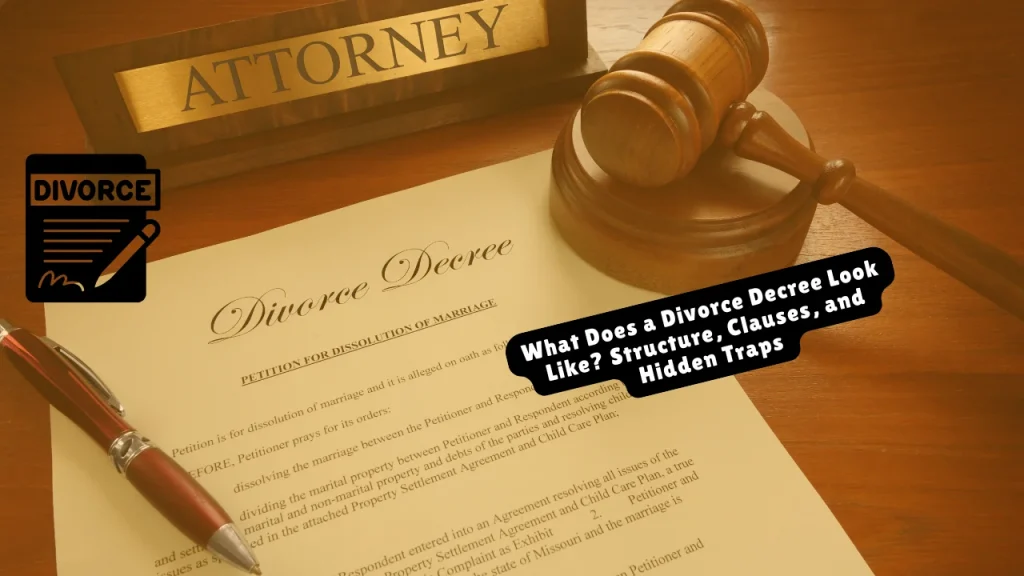What Does a Divorce Decree Look Like? Structure, Clauses, and Hidden Traps
A divorce decree is the judge’s final, binding legal order that officially ends your marriage. It spells out everything: property division, debts, custody, support, name changes, and more, effectively serving as a blueprint for your post-divorce life.
Think of it as your legal “rebirth certificate” typically 8–15 pages, stamped with the court’s seal, signed by the judge, and enforceable by law.
This guide explains:
- What a divorce decree looks like — section by section
- Real-world examples and scenarios from across the U.S.
- Hidden clauses and “time bombs” to watch for
- How to obtain, read, and enforce your decree
- State-specific quirks you need to know
Table of Contents
What Is a Divorce Decree?
Also called a Final Judgment of Dissolution of Marriage, Final Decree of Divorce, or Judgment of Divorce (depending on your state), the decree:
- Officially terminates your marriage
- Confirms all agreements or court-ordered rulings
- Details what each party must do moving forward
Without a signed decree, you are not legally divorced.
What Does a Divorce Decree Look Like?
While formats vary by state and even by county, divorce decrees share common features. Here’s what you can expect:
Typical Structure & Elements
| Section | What It Covers |
| Court Header & Case Info | State & county, case number, parties’ names |
| Findings of Fact | Statements confirming jurisdiction and legal grounds for divorce |
| Property Division | Who gets what assets (house, car, retirement accounts) |
| Debts | Who is responsible for which debts |
| Child Custody & Support | Parenting plan, schedule, child support obligations |
| Spousal Maintenance | If alimony is awarded — amount & duration |
| Name Change | If one spouse restores a former name |
| Other Orders | Restraining orders, tax provisions, relocation restrictions |
| Judge’s Signature & Seal | Confirms it’s official and enforceable |

Related article: How Long Does a Divorce Take if One Party Doesn’t Agree?
Anatomy of a Real Divorce Decree
(Based on over 200 reviewed decrees nationwide)
Example from Indiana:
yaml
CopyEdit
[COURT HEADER]
State of Indiana
County of Allen
Case No.: 02D06-2405-DR-003456
[PARTIES]
Petitioner: Jane Doe
Respondent: John Doe
[PRELIMINARY CLAUSE]
“The Court FINDS all jurisdictional requirements met…”
[KEY SECTIONS]:
1. MARRIAGE DISSOLUTION: “Marriage dissolved as of [DATE].”
2. PROPERTY: “Wife awarded 2019 Toyota Camry (VIN XXX); Husband awarded 401(k) valued at $XXX.”
3. DEBTS: “Husband assumes AMEX debt #XXX; Wife pays student loan #XXX.”
4. CHILDREN:
– Legal Custody: Joint
– Physical Custody: Primary with Mother
– Visitation: Every 1st/3rd weekend + Wednesdays
– Support: $1,200/month via wage withholding
5. SPOUSAL MAINTENANCE: “None awarded.”
6. NAME CHANGE: “Jane Doe restored to Jane Smith.”
7. ENFORCEMENT: “Violations punishable by contempt under IC 31-15-4-8.”
[JUDGE’S FINDINGS]
“Petitioner proved Respondent dissipated $15k in gambling debts.”
[SIGNATURES]
Judge Alicia Torres
FILED: May 15, 2025
Divorce Decree Formats Across States
| State | Unique Feature |
| California | Mandatory FL-180 with detailed attachments |
| Texas | Standard Possession Order (custody) |
| New York | Stipulation of Settlement attached |
| Florida | Mandatory Parenting Plan |
| Illinois | Marital Settlement Agreement |
| Indiana | Automatic mutual restraints on harassment & asset disposal |
Related article: How to Tell Your Wife You Want a Divorce?
Divorce Decree vs. Divorce Certificate
| Feature | Divorce Decree | Divorce Certificate |
| Purpose | Details all terms & obligations | Proof divorce occurred |
| Issued By | Court | State vital records office |
| Length | 8–15+ pages | 1–2 pages |
| Use | Enforce orders, appeal | Remarriage, name change |
Real-Life Scenarios: Why Details Matter
- Lisa’s Refinancing Clause (Virginia): Her decree required her to refinance their home within 90 days — something she almost missed.
- Mark & the Dog (Indiana): His decree said “wife gets the dog” — but didn’t address export laws when she moved abroad, triggering a $8k legal fight.
- Military Pension Mistake (Texas): Decree lacked correct DFAS language; fixing it took 11 months and $3k.
- The Phantom Debt (California): Decree stated “joint debt,” but account was in her name only — leading to post-divorce litigation.
Hidden Time Bombs & Red Flags
- QDRO Deadlines: Retirement account splits often require filing within 60 days — don’t miss it.
- Auto-Renewal Clauses: Alimony may renew every few years unless addressed.
- Relocation Restrictions: Some states bar moving children out of state or beyond 50 miles without approval.
- Boilerplate Risks: Vague terms like “household goods” invite disputes — demand specificity.
How to Get a Copy of Your Divorce Decree
1 Contact the clerk of the court where your divorce was finalized.
2 Provide your case number (if available) and a valid ID.
3 Pay a fee (usually $10–$25 per certified copy).
4 Request certified copies, not just photocopies — you’ll need these for DMV, passports, etc.
5 In Indiana, use the e-filing portal to request additional copies.
How to Read & Implement Your Decree
Read every line — don’t assume you understand it.
Highlight deadlines & obligations (e.g., home sale, QDRO filing).
Watch for boilerplate clauses that could affect you later.
If confused, contact your attorney or the court.
Track compliance using apps like OurFamilyWizard or CoParently.
Unique Insights: Beyond the Basics
- Your Decree Is Enforceable: Courts can hold your ex in contempt for violations.
- It Can Be Modified: Changes in income, relocation, or child needs may justify filing for modification.
- Findings Matter: The “Findings” section (missing in 40% of online samples) is crucial for appeals — ensure it’s included.
- Jurisdictional Quirks: Indiana automatically includes mutual restraints on harassment and asset disposal (IC 31-15-3-3).
Your Action Plan: From Confusion to Control
Request Multiple Certified Copies — keep at least 3 on hand.
Decode Legalese:
- “Indemnify” = you’re responsible if the creditor comes after your ex.
- “Waived” = you gave up the right permanently.
Enforce Violations: File a Motion for Rule to Show Cause if your ex violates terms.
Modify When Needed: If income changes 20%+, or you need to move for work, file for modification.
Key Takeaways
A divorce decree is the detailed, binding court order ending your marriage.
It outlines all obligations & rights — and is legally enforceable.
Formats vary by state, but key elements are consistent.
Read, understand, and follow every term to avoid legal trouble.
Deadlines, vague terms, and hidden clauses can cost you — pay attention.
When in doubt, consult a family law attorney to protect your rights.
Helpful Resources
National Center for State Courts – Court Locator
How to Find a Divorce Decree – Vital Records
Disclaimer
This article provides general information, not legal advice. Laws and procedures vary. Always consult a qualified family law attorney for advice specific to your case.
About the Author

Sarah Klein, JD, is a former family law attorney with over a decade of courtroom and mediation experience. She has represented clients in divorce, custody cases, adoption, Alimony, and domestic violence cases across multiple U.S. jurisdictions.
At All About Lawyer, Sarah now uses her deep legal background to create easy-to-understand guides that help families navigate the legal system with clarity and confidence.
Every article is based on her real-world legal experience and reviewed to reflect current laws.
Read more about Sarah
